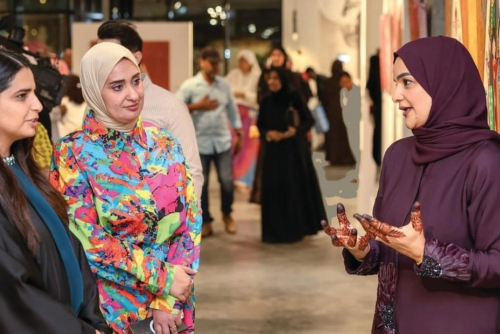Artist Al Fadala explores Bahraini heritage through contemporary visual dialogue
TDT | Manama
Email: mail@newsofbahrain.com
In a striking exhibition that bridges the past with the present, Bahraini artist Hajar Nasser Al Fadala presents a contemporary reinterpretation of the Kingdom’s rich cultural heritage.
Titled “Allow Popular Heritage”, the exhibition was held last April at the Safia Ali Kanoo Art Centre, and attended by Shaikha Dawa bint Khalid bin Abdullah Al Khalifa, a member of the National Council for Arts.
Drawing inspiration from Bahrain’s deep civilisational roots — from the ancient Dilmun era to the symbols of popular heritage — Al Fadala reconstructs cultural elements through artworks that combine technical simplicity with semantic richness.
Visual dialogue
Her pieces invite viewers into a visual dialogue between cultural memory and modern identity, raising questions about the evolving place of heritage in contemporary life.
Rather than presenting heritage as a fixed narrative, Al Fadala’s work transforms it into an interactive concept, encouraging viewers to engage critically with their cultural surroundings.
Central to her artistic vision is the traffic sign, particularly the red triangle meaning “allow passage,” which she uses as a metaphor for societal attitudes toward heritage.
Symbolic tool
In this context, the sign becomes a symbolic tool, suggesting either the integration or exclusion of heritage from everyday life.
“The works aren’t nostalgic or documentary,” Al Fadala explains, “but rather symbolic structures offering a new reading of place and identity.”
Her compositions evoke collective memory, while the background colours — earthy browns, beiges, and the texture of palm fronds — reflect architectural traditions and domestic spaces of old Bahraini homes.
These tones root the viewer in the physical and emotional geography of the past.
Colour contrasts
Al Fadala also employs colour contrasts — red, yellow, and green — as psychological cues representing public attitudes toward heritage. Red symbolizes rejection, yellow suggests hesitation, and green reflects openness and continuity.
Through these choices, she crafts a layered narrative about how society negotiates with its cultural inheritance.
In addition to her exploration of popular culture, the artist delves into Dilmun iconography, especially ancient Dilmun seals, which she reinterprets through a modern lens.
These elements serve not only as historical references but as living components of contemporary identity.
In a unique gesture, she incorporates the red shemagh as a visual and cultural bridge, linking modern Gulf identity to the shared heritage of the region.
“Allow Popular Heritage” offers more than visual appreciation — it challenges the viewer to consider how heritage lives, evolves, and continues to shape the present.
Through her thoughtful compositions, Al Fadala opens space for reflection on cultural continuity, collective memory, and the dynamic interplay between tradition and modernity.
Related Posts


